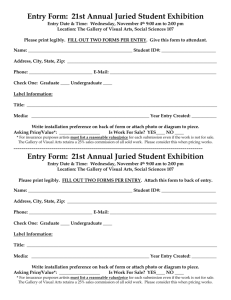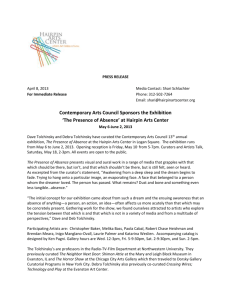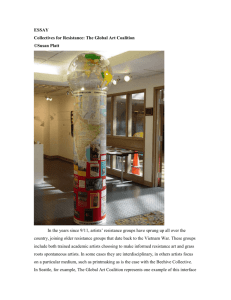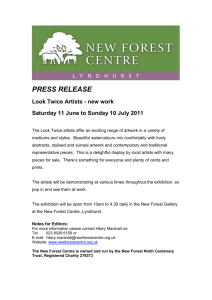flux flow flight - London Borough of Richmond upon Thames
advertisement
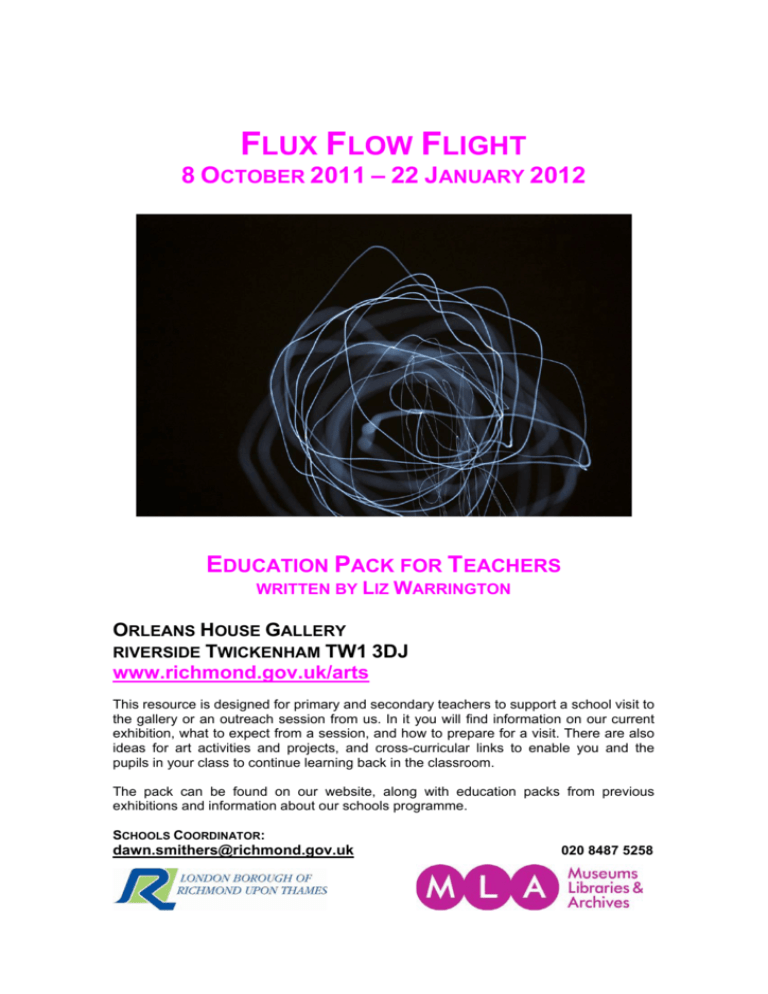
FLUX FLOW FLIGHT 8 OCTOBER 2011 – 22 JANUARY 2012 EDUCATION PACK FOR TEACHERS WRITTEN BY LIZ WARRINGTON ORLEANS HOUSE GALLERY RIVERSIDE TWICKENHAM TW1 3DJ www.richmond.gov.uk/arts This resource is designed for primary and secondary teachers to support a school visit to the gallery or an outreach session from us. In it you will find information on our current exhibition, what to expect from a session, and how to prepare for a visit. There are also ideas for art activities and projects, and cross-curricular links to enable you and the pupils in your class to continue learning back in the classroom. The pack can be found on our website, along with education packs from previous exhibitions and information about our schools programme. SCHOOLS COORDINATOR: dawn.smithers@richmond.gov.uk 020 8487 5258 VISITING US: Gallery Sessions for schools usually run for 90 minutes. This is made up of an interactive tour of the exhibition, followed by a practical art session inspired by the works on display. We have a flexible policy and consider each workshop to be unique. Please let us know if you would like to alter any aspect of your workshop. The cost of a gallery session is £2.50 per child. Pastoral: Children will be able to leave their coats and use the toilet before the session begins. Please let us know if you need an indoor space for eating packed lunches. You are also welcome to use our grounds. We have a fantastic outdoor space for children to burn off any excess energy during their lunch break! Photography: is permitted within the education space, but please ask your educator before taking photographs in the gallery space, as many of our art works are protected by copyright laws. Risk Assessment: We ask each school to undertake their own, as each of our sessions is so different. However we can provide a sample risk assessment on request. If you have any other questions please contact the education team prior to your visit. Transport: • Train: St Margaret’s (15mins) and Twickenham (25 mins). • Bus routes: 33, 490, H22, R68, R70 (alight at Crown Road) • Coach: Please note that coaches cannot fit down Orleans Park Road. Please ask your driver to stop at the entrance to Marble Hill Park. Allow an extra 10 minutes to walk to the gallery. Shop and Café: We have a gallery shop selling pencils, postcards and other exhibitionrelated gifts at pocket money prices. All proceeds from the shop go directly back into our education programme. Our café is open from Tuesday to Friday, selling hot and cold drinks and a variety of sandwiches and cakes. OUTREACH VISITS: Outreach sessions for schools usually last between 60 and 120 minutes. This is made up of an introduction to the gallery and current exhibition, followed by a practical art session linked to the artwork that you have been shown. We have a flexible policy and consider each workshop to be unique. Please discuss your individual needs with your art educator at the time of booking. The cost of an outreach session is £3 per child, including all resources. Resources: The gallery will provide all resources required for the workshop, unless otherwise specified. Resources will either be sent to the school prior to the workshop, or will be brought on the day by the art educator. We ask that you cover tables before we arrive and that you provide art overalls for the children. EXHIBITION INFORMATION: Flux Flow Flight was inspired by the many different ways visual artists depict physical movement, locomotion and passage of time through art, from paintings and photography through to video art, dance and performance. The exhibition follows the way artists have used movement in art through developments in modern art history such as photography, the influence of film, cinema and the Futurism, Vorticism, Surrealism and Op Art movements. The artists and ethos of the Futurist movement were a major influence on the exhibition. They were an international group of artists, mainly based in Italy and Russia practicing at the beginning of the twentieth century, active across all creative disciplines but most significantly in the visual arts and poetry. In 1909 poet Filippo Tommaso Marinetti wrote the Futurist Manifesto, rejecting all that had gone before and laying out the Futurist movements principles and explaining their fascination with the modern world and technology and industry. Their work focused on speed, noise, pollution, cities, machines, war and celebrating and embracing the exhilarating new world. This manifesto gives the exhibition context. Artists were fascinated with capturing movement in our modern world then, and are still doing that today. Flux Flow Flight is an open exhibition. This means that any artist could submit work for the exhibition. We looked at over 600 art works, and from this, chose about 60 to be exhibited in the gallery. The artists chosen are all currently living and working in the UK. Alongside these artworks are works from the Richmond Borough Art Collection that address themes of flux (light, atmosphere, colour), flow (water, movement of boats, people and clouds) and flight (horses, birds, aeroplanes). Other works by artists such as Muybridge have been loaned to us from other galleries as they are significant to the theme of the exhibition. We also invited artists including Jackie Matisse to exhibit some work relevant to the theme. As you walk around the exhibition you will also notice several art works created through education projects here at the gallery. We always exhibit art made by young people on our education programmes. ARTIST FOCUS: JACKIE MATISSE Jackie Matisse is a contemporary French artist. She is the granddaughter of Henri Matisse (1869-1954). Her kite tail works, made from paper and fabric demonstrate movement and form in both airborne and underwater environments. "I make and fly kites to play with colour and line in the sky. My kites play games with the light, hide and seek with the clouds. They push and pull on the wind. They challenge the birds. My hand grows longer and longer until I feel I am somehow in contact with that immensity into and out of which all things come and go. The kite itself is a reference to the human: so fragile and yet so strong. It is also a reference to constant movement, sinuous movement, the movement of dreams and childhood. A child on the street rarely walks in a straight line. It plays while it goes, in and out, around and about. That is what birds in flight do. That is what my kites do. I wish to create "sky works" however ephemeral. Kites are an instrument for this. They put line and colour into the sky and sculpt the air. They play a game of freedom." Her passion for kites began in the 1960s, when she was in a taxi going to the airport in New York. She saw a single kite flying over Harlem that appeared to her like a “line drawn in the sky,” this image inspired her to draw “on the canvas of the sky” and create “Art Volant” (flying art). Several of her kite tails appear in the exhibition. One of her mobiles is also represented. Matisse’s mobiles are influenced by Alexander Calder (1898-1976). Again, movement is implied and found materials are used. In her local market place of Nemours in the 1960s, a tableware vendor was breaking some of his dishes in the street to advertise his plates (“Buy them or I will break them!”). Matisse noticed that the broken ceramic pieces lying on the street resembled the phases of the Moon, which was a big influence at the time as the Apollo Mission had just landed a man on the moon for the first time. This experience resulted in her use of broken dish shards as stencils for the simple shapes in her mobiles. ARTIST FOCUS: EADWEARD MUYBRIDGE Eadweard Muybridge (1830-1904) was a photographer. He was born in Kingston although he spent much of his life in the US. Kingston Museum holds the largest collection of his work in the world, he bequeathed a lot of his photographs, slides and equipment to them and they have loaned some of it for the Flux, Flow, Flight exhibition. He took many different kinds of photographs including documentary, architectural, landscape and war photography, but is most well known as a pioneer of stop motion photography where he explored human and animal movement. He took a series of images using several cameras in a line that the subject would move past; triggering a thread attached to each camera as they passed it, thereby capturing each individual stage of the whole movement. Originally this method was used to discover whether racehorses ever lifted all four of their legs off the ground at any point whilst galloping, this was a source of speculation amongst artists and people in the sport. Another figure in Flux, Flow, Flight, Ếtienne Jules de Marey had tried to find this out through long exposure photography but the results were too blurred, Muybridge followed Marey’s experiments and discovered that horses did indeed lift all their legs at the same time but whilst the legs are tucked underneath not outstretched as artists had previously always depicted them. Muybridge used the same method to photograph many different kinds of animals moving as well as various types of human motion. ART AND ACTIVITIES: • Look at Eadweard Muybridge’s series of photographs of animals moving, using the burst mode on a digital camera where the camera takes a quick burst of shots with one click, take some photographs of each other moving. Create a series similar to Muybridge’s or make flick books. • Barbara and Zafer Baron make their photographs by leaving the shutter of their camera open for a long time and using the light of the stars and the moon to make drawings. You can recreate this effect by using a very slow shutter speed on a digital camera and making drawings by wiggling a torch around in a dark room. Try writing words, make drawings beforehand and try to recreate them, experiment with exposure times and blurring. • Look at transport posters from the twentieth century. They were designed to be exciting and sell trips and holidays. Thinking about design and layout, make your own posters that convey motion, speed, direction, destination. Use photoshop, collage, paint backgrounds and flat blocks or sections to simplify sourced images or photographs, paint onto layers of acetate. • Use a bright light and get the students to draw each other’s silhouettes onto black sugar paper, cut around the outline, make profile portraits or strike a pose! TO QUESTION: • All the works in the exhibition are about movement, but there are different kinds of movement; these may be physical movements and gestures of the human body, the ways animals move and machine driven movement. What different kinds of movement can you see? How many words can you think of to describe ways of moving? What does movement mean to you? • Is progress and technology a positive or negative thing? The Futurist movement began at the beginning of the 20th century when a lot of exciting technological and industrial developments were happening and the world was changing very fast. The artists involved embraced these changes and their work celebrated the modern world. Looking back do you agree with them? Have changes such as the invention of cars, aeroplanes, factories and machines made the world a better place to live in or are there negative aspects to this development? Can you imagine a world without these technologies? Do you think more current technological developments are changing the world for the better e.g. computers, the internet, iphones? What kind of machines and technologies can you imagine being invented in a hundred years? • Jackie Matisse makes kites as part of her art. Look at where kites where come from and what purposes they have been used for. Look at different designs. Imagine you are flying a kite a long long way, where would you fly over, what would you see, where would you go to? PRIMARY NATIONAL CURRICULUM LINKS: KS1: • Art and Design 1a,b; 2a,b,c; 3a; 4a,b,c; 5a,b,c,d • Science Sc2: 5a,b,c; Sc3: 1a Breadth of Study: 1a,b,c; 2a KS2: • Art and Design 1a,b,c; 2a,b,c; 3a; 4a,b; 5a,b,c,d. • Science Breadth of study 1a,b,c; 2a E-LEARNING: • In 2009 Tate Modern held a Futurism exhibition to celebrate the 100th anniversary of the publication of the Futurist Manifesto http://www.tate.org.uk/modern/exhibitions/futurism/rooms/room1.shtm • The Futurist Manifesto http://www.italianfuturism.org/manifestos/foundingmanifesto/ • Kites http://en.wikipedia.org/wiki/Kite • Eadweard Muybridge http://www.eadweardmuybridge.co.uk/ • Alexander Calder influenced a lot of the work in the exhibition, look at his mobiles, wire sculptures and circus http://calder.org/home.html • Calder’s circus http://www.youtube.com/watch?v=t6jwnu8Izy0 • Transport posters at the London Transport Museum http://www.ltmcollection.org/posters/index.html GLOSSARY: • Flux: Continuous change, a sense of motion, instability, fluctuation. • Futurism: An art movement based in Italy at the beginning of the 20th century, concerned with ideas of machines, technology, progress, modernity and motion. Artists included Filippo Tommaso Marinetti who wrote the Futurist Manifesto in 1909, Umberto Boccioni and Giacomo Balla. • Vorticism: A British art movement in the early 20th century responding to the Futurist interest in dynamism, the machine age and modernity. Artists included Wyndham Lewis, Jacob Epstein, David Bomberg and the poet Ezra Pound. They produced the literary magazine Blast. • Surrealism: An international art movement that wrote and made art that came from the subconscious, using inspiration from dreams, psychoanalysis and spontaneous processes such as automatic writing and drawing. Often used the juxtaposition of contradictory images. • Op Art: A style of art that uses optical illusions to make abstract patterns and images appear to move. Artists include Bridget Riley. • Manifesto: A written statement of the beliefs, aims and philosophies of a group or organisation. • Stop motion photography: Taking a series of photographs of something moving or being moved. Can be used as a method of animation. In Muybridge’s case the photos were all taken within a matter of seconds. • Long exposure: Opening the shutter of a camera for a long period of time, anywhere from half a second to several minutes, this allows more light in but can make the photo more blurry. • Burst mode: A mode on a camera where several photographs can be taken in a small period of time with one click.
